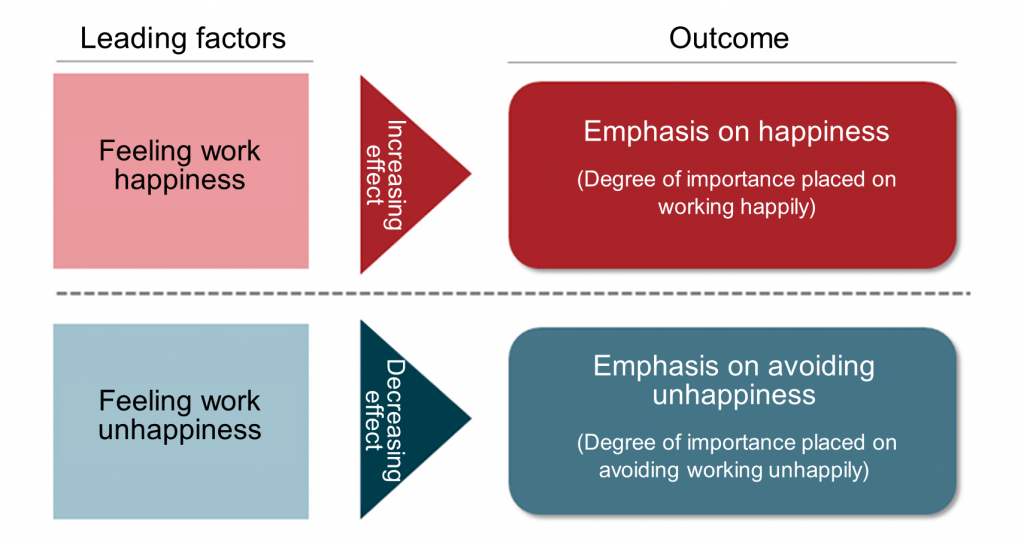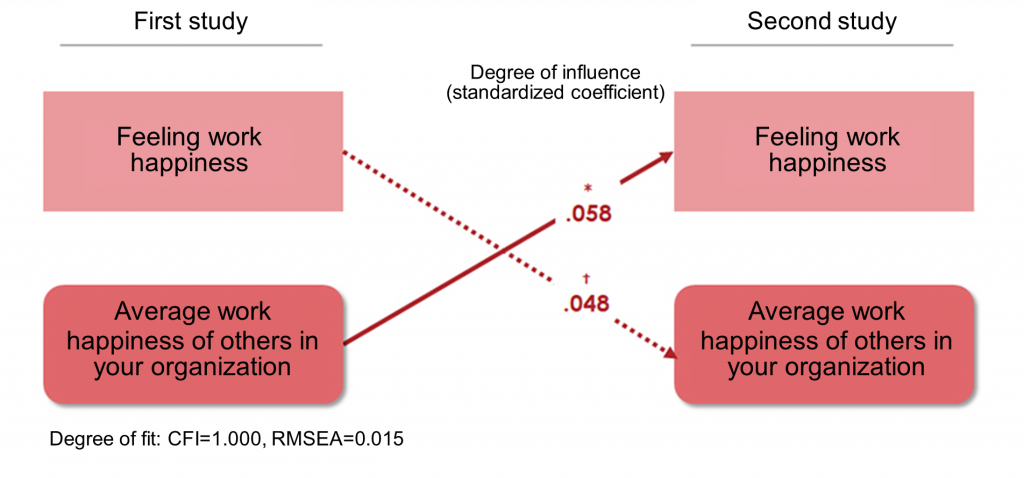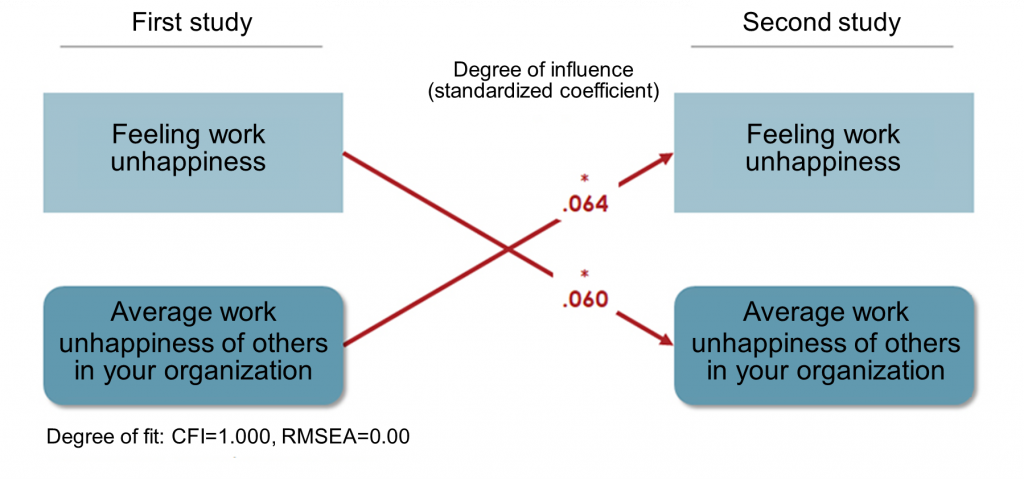Is it important for individuals to “work happily”? Does it lead to improved work performance? Additionally, does “work happiness” expand and spread?
Mari Kanemoto, a Think Tank Headquarters researcher at Persol Research and Consulting Co., Ltd., has contributed a two-part article on research findings regarding the effects of “happiness through work.”
In today’s column, Part 2, we explore whether feeling happiness through work enhances the happiness of individuals and organizations.
In the previous article, I explained that feeling happiness through work and factors of work happiness are effective in boosting the performance of individuals and organizations. In this article, I will discuss another effect of feeling happiness through work.
When people become happy through their work, they experience a shift in their sense of values that places importance on working happily.
In our survey, we also analyzed this change in people’s sense of values that stresses the importance of working happily.
Through the results of the first study in July 2020, we had already confirmed the relationship (correlation coefficient: 0.49) that the more people felt working happily to be important, the happier they felt through their work. Based on this result, we initially thought that people who believed that it is important to work happily strive to work happily because of this belief and, as a result, are able to work happily.
The results of our empirical study, however, revealed the opposite causal relationship: namely, that the happier that people feel through their work, the more they come to believe that working happily is important (see fig. 4). Findings also indicated that, as unhappiness through work increased, there was a causal relationship resulting in people feeling that avoiding unhappiness in work to be not particularly important (a form of paralysis).
Fig. 4. Causal relationship between feeling happiness/unhappiness through work and emphasis on happiness/avoiding unhappiness

In other words, it isn’t possible to control one’s own working happiness or unhappiness according to the degree to which one values the importance of working happily, but rather the degree to which one values the importance of working happily changes in accordance with the level of happiness or unhappiness with one’s circumstances. When management stresses the importance of employees’ work happiness, if actually feeling work happiness is considered to be the current indicator, then the sense of value of employees’ happiness or unhappiness through work could be viewed as a lagging KPI.
Happiness through work is contagious
A previous study in the field of well-being showed that happiness is “contagious” and can spread from person to person1. People who have a friend living within a mile who is happy increase their probability of becoming happy by 25 percent. As for happiness through work, the study also suggested that this phenomenon of happiness being contagious occurs in companies.
A significant effect that was confirmed through the study was that when the average happiness level experienced by other members in the same department was high, then our own happiness level also increased (see fig. 5). In addition, the study found that when our sense of happiness was high, the average sense of happiness of the members around us also increased, although the degree of influence was slightly lower. The same significant “emotional contagion” effect between people that was seen with work happiness was also confirmed for feelings of work unhappiness.
Fig. 5. Causal relationship between own feelings of work happiness/unhappiness and work happiness/unhappiness of others in organization


*: significant at 5% level
†: significant at 10% level
Note: Analysis by covariance structure analysis. The degree of influence between the same variables from the first to the second round has been omitted. Arrows indicate causal relationships between variables.
These results reveal a temporal relationship between happiness and unhappiness: when the happiness or unhappiness of those around us is high, our own happiness or unhappiness increases a few months later. Accordingly, we can deduce that it is not the similarity of the work environment, such as the kind of work being performed and overtime hours, that determines whether people in the same department feel happy or unhappy, but rather the contagious nature of happiness and unhappiness. Based on this premise, it could be useful to use the happiness index as a reference when transferring and posting personnel, for example, by assigning unhappy people to happy departments to increase their happiness.
Wrap-up and intervention methods
Based on the results of our empirical study, we determined that a sense of happiness through work enhances work engagement and organizational commitment, and has a positive impact on individual behavior and performance. We also found that it strengthens our individual values regarding the importance of working happily and acts as an emotional contagion between people.
When we talk about pursuing work happiness, we sometimes hear concerns that it may lead to self-centered behavior and a decline in diligence. But our findings quantitively indicate that feeling happy through work actually has a positive effect on performance.
The concept of well-being management has long been advocated as a management strategy aimed at achieving employee happiness and, as a result, generating profits2. These results also revealed that happiness and unhappiness through work is effective as one of the non-financial indicators (non-financial KPI) that companies should aim for.
So, what can each of us do to become happier through our work?
Based on the results of the first study, it is clear that an effective approach to increasing our sense of happiness in the workplace while decreasing our sense of unhappiness requires improvements in the seven factors of work happiness and seven factors of work unhappiness.
Accordingly, I would encourage you to measure these 14 factors with regard to your workplace and yourself as a means of gaining an understanding of which aspects are lacking and which are sufficient for you to attain happiness through work. This will enable you to act toward improving your situation.
For those interested, we offer a free-of-charge online Well-Being at Work diagnostic survey (Well-Being at Work Scale; WaW77) on our website (in Japanese) that measures the seven factors of work happiness and seven factors of work unhappiness (14 factors in all).
1) Fowler et al. (2008) Dynamic spread of happiness in a large social network: longitudinal analysis over 20 years in the Framingham Heart Study, BMJ 2008; 337:a2338
2) Takeshi Maeno, Hiroshi Komoriya, Shiroh Tenge (2018) Well-being×Management: Next-Generation Japanese-Style Organizations Will Change the World
This article was published with the permission of Mari Kanemoto of Persol Research and Consulting Co., Ltd. It has been partially modified from its original format. The original article (in Japanese) can be viewed at the following link.
・Feeling happiness through work: Results of an empirical study of companies (Published on May 28, 2021)
Related links:
・Persol Research and Consulting
・The Working People’s Well-Being Project (in Japanese) (Published on July 15, 2020; Last updated on May 28, 2021)
・Results of Survey on Working People’s Happiness (in Japanese) (July 2020)
・Results of Empirical Study of Working People’s Happiness (in Japanese) (May 2021)

